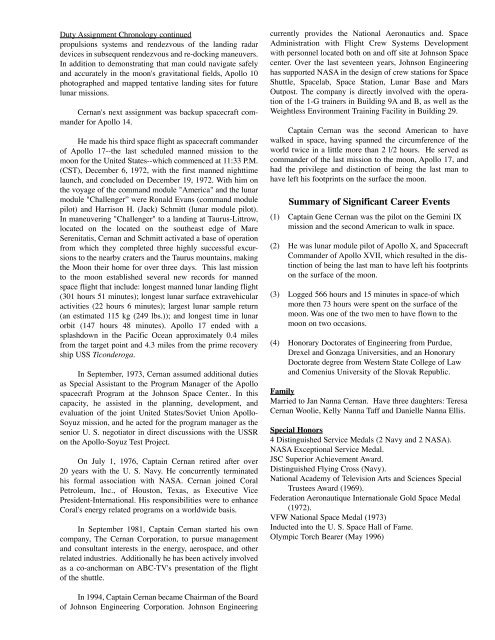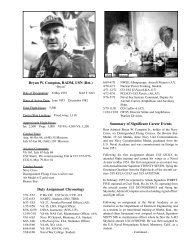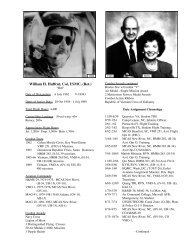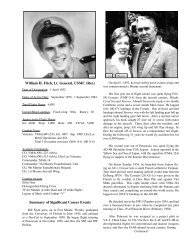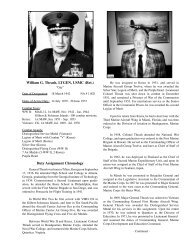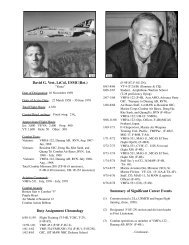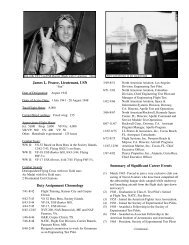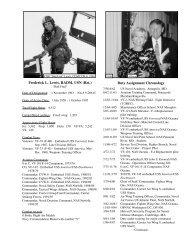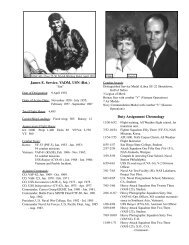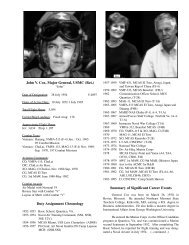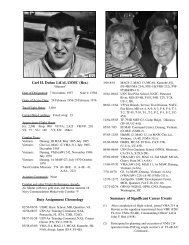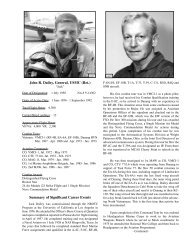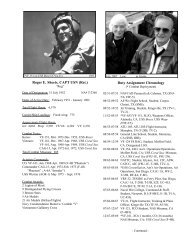Eugene A. Cernan, Captain, USN (Ret.) Professional Background ...
Eugene A. Cernan, Captain, USN (Ret.) Professional Background ...
Eugene A. Cernan, Captain, USN (Ret.) Professional Background ...
You also want an ePaper? Increase the reach of your titles
YUMPU automatically turns print PDFs into web optimized ePapers that Google loves.
Duty Assignment Chronology continued<br />
propulsions systems and rendezvous of the landing radar<br />
devices in subsequent rendezvous and re-docking maneuvers.<br />
In addition to demonstrating that man could navigate safely<br />
and accurately in the moon's gravitational fields, Apollo 10<br />
photographed and mapped tentative landing sites for future<br />
lunar missions.<br />
<strong>Cernan</strong>'s next assignment was backup spacecraft commander<br />
for Apollo 14.<br />
He made his third space flight as spacecraft commander<br />
of Apollo 17--the last scheduled manned mission to the<br />
moon for the United States--which commenced at 11:33 P.M.<br />
(CST), December 6, 1972, with the first manned nighttime<br />
launch, and concluded on December 19, 1972. With him on<br />
the voyage of the command module "America" and the lunar<br />
module "Challenger” were Ronald Evans (command module<br />
pilot) and Harrison H. (Jack) Schmitt (lunar module pilot).<br />
In maneuvering "Challenger" to a landing at Taurus-Littrow,<br />
located on the located on the southeast edge of Mare<br />
Serenitatis, <strong>Cernan</strong> and Schmitt activated a base of operation<br />
from which they completed three highly successful excursions<br />
to the nearby craters and the Taurus mountains, making<br />
the Moon their home for over three days. This last mission<br />
to the moon established several new records for manned<br />
space flight that include: longest manned lunar landing flight<br />
(301 hours 51 minutes); longest lunar surface extravehicular<br />
activities (22 hours 6 minutes); largest lunar sample return<br />
(an estimated 115 kg (249 lbs.)); and longest time in lunar<br />
orbit (147 hours 48 minutes). Apollo 17 ended with a<br />
splashdown in the Pacific Ocean approximately 0.4 miles<br />
from the target point and 4.3 miles from the prime recovery<br />
ship USS Ticonderoga.<br />
In September, 1973, <strong>Cernan</strong> assumed additional duties<br />
as Special Assistant to the Program Manager of the Apollo<br />
spacecraft Program at the Johnson Space Center.. In this<br />
capacity, he assisted in the planning, development, and<br />
evaluation of the joint United States/Soviet Union Apollo-<br />
Soyuz mission, and he acted for the program manager as the<br />
senior U. S. negotiator in direct discussions with the USSR<br />
on the Apollo-Soyuz Test Project.<br />
On July 1, 1976, <strong>Captain</strong> <strong>Cernan</strong> retired after over<br />
20 years with the U. S. Navy. He concurrently terminated<br />
his formal association with NASA. <strong>Cernan</strong> joined Coral<br />
Petroleum, Inc., of Houston, Texas, as Executive Vice<br />
President-International. His responsibilities were to enhance<br />
Coral's energy related programs on a worldwide basis.<br />
In September 1981, <strong>Captain</strong> <strong>Cernan</strong> started his own<br />
company, The <strong>Cernan</strong> Corporation, to pursue management<br />
and consultant interests in the energy, aerospace, and other<br />
related industries. Additionally he has been actively involved<br />
as a co-anchorman on ABC-TV's presentation of the flight<br />
of the shuttle.<br />
In 1994, <strong>Captain</strong> <strong>Cernan</strong> became Chairman of the Board<br />
of Johnson Engineering Corporation. Johnson Engineering<br />
currently provides the National Aeronautics and. Space<br />
Administration with Flight Crew Systems Development<br />
with personnel located both on and off site at Johnson Space<br />
center. Over the last seventeen years, Johnson Engineering<br />
has supported NASA in the design of crew stations for Space<br />
Shuttle, Spacelab, Space Station, Lunar Base and Mars<br />
Outpost. The company is directly involved with the operation<br />
of the 1-G trainers in Building 9A and B, as well as the<br />
Weightless Environment Training Facility in Building 29.<br />
<strong>Captain</strong> <strong>Cernan</strong> was the second American to have<br />
walked in space, having spanned the circumference of the<br />
world twice in a little more than 2 l/2 hours. He served as<br />
commander of the last mission to the moon, Apollo 17, and<br />
had the privilege and distinction of being the last man to<br />
have left his footprints on the surface the moon.<br />
Summary of Significant Career Events<br />
(1) <strong>Captain</strong> Gene <strong>Cernan</strong> was the pilot on the Gemini IX<br />
mission and the second American to walk in space.<br />
(2) He was lunar module pilot of Apollo X, and Spacecraft<br />
Commander of Apollo XVII, which resulted in the distinction<br />
of being the last man to have left his footprints<br />
on the surface of the moon.<br />
(3) Logged 566 hours and 15 minutes in space-of which<br />
more then 73 hours were spent on the surface of the<br />
moon. Was one of the two men to have flown to the<br />
moon on two occasions.<br />
(4) Honorary Doctorates of Engineering from Purdue,<br />
Drexel and Gonzaga Universities, and an Honorary<br />
Doctorate degree from Western State College of Law<br />
and Comenius University of the Slovak Republic.<br />
Family<br />
Married to Jan Nanna <strong>Cernan</strong>. Have three daughters: Teresa<br />
<strong>Cernan</strong> Woolie, Kelly Nanna Taff and Danielle Nanna Ellis.<br />
Special Honors<br />
4 Distinguished Service Medals (2 Navy and 2 NASA).<br />
NASA Exceptional Service Medal.<br />
JSC Superior Achievement Award.<br />
Distinguished Flying Cross (Navy).<br />
National Academy of Television Arts and Sciences Special<br />
Trustees Award (1969).<br />
Federation Aeronautique Internationale Gold Space Medal<br />
(1972).<br />
VFW National Space Medal (1973)<br />
Inducted into the U. S. Space Hall of Fame.<br />
Olympic Torch Bearer (May 1996)


